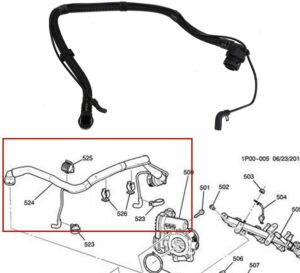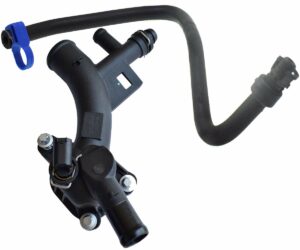The cooling system is not only responsible for keeping the cabin cool in the heat of the summer but it also ensures that the engine does not overheat while in use. The water pump circulates the coolant through the hoses and ensures your engine maintains its performance even through demanding tasks. If the coolant level gets too low, the engine will not get enough coolant and begin to overheat. The water pump could also fail as it has to perform twice the work to circulate the low level of coolant to cool the engine.
If you notice any problems with your cooling system or you find that your coolant levels are dropping too fast, this 2011 Chevy Cruze coolant hose diagram should help you find out the problem. We also included a guide on how to check your coolant levels and add coolant to the coolant surge tank.
2011 Chevy Cruze Coolant Hose Diagram


How to Add Coolant to the Coolant Surge Tank
The Chevy Cruze cooling system is filled with engine coolant designed to remain in the vehicles for 5 years or 150,000 miles, whichever occurs first. If you meet this mark, it is recommended that you check if the coolant level is low and add coolant immediately. This guide will help you with checking and adding coolant to the coolant surge tank.
Checking Coolant
- Before you open the hood, ensure that the vehicle is on a level surface.
- You will find the coolant surge tank in the engine compartment on the driver side of the vehicle
- Check the coolant tank to see if the coolant is still visible. If you coolant inside the tank is boiling, wait until it cools down.
- Check if the coolant level is at the indicated mark in the coolant surge tank. If it is below the mark, then you will have to add coolant.
Which Coolant to Use
Avoid adding only plain water or some other liquid to the cooling system as this can be dangerous. Plain water and other liquids could boil before the proper coolant mixture which will lead to cooling system problems. This will make the engine get too hot, however, you might not get the overheat warning. In some cases, the engine could catch fire leading to a serious accident.
You should only use a 50/50 mixture of clean distilled water and coolant
This mixture
- Provides freezing protection down to −37°C (−34°F), outside temperature
- Provides boiling protection up to 129°C (265°F), engine temperature
- Protects against corrosion and rust
- Will not cause damage to aluminum parts
- Will help keep the proper engine temperature
Ensure that there is not too much water in the mixture or it will freeze and crack the engine, heater core, radiator, and parts. Also, the remaining coolant should not be disposed of in the trash, poured on the ground, or into the sewer or bodies of water. Have the coolant disposed of properly rather than into the environment.
Adding Coolant to the Coolant Surge Tank
Take note of the vehicle coolant fill procedure and follow it accordingly to prevent engine overheating and damage. Before adding coolant, allowing the engine to cool properly. Steam or scalding liquid from a hot cooling system can burn you badly. You should also avoid turning the coolant surge tank pressure cap when the cooling system is hot.
- Remove the coolant surge tank cap
- Wait till the coolant surge tank pressure cap and upper radiator hose are cool, then remove the coolant surge tank pressure cap.
- Turn the pressure cap slowly counter-clockwise, one-quarter of a turn. If you hear a hiss, wait a while till it stops. This will vent out any remaining pressure through the discharge hose.
- Keep turning the pressure cap slowly to vent out any remaining pressure.
- When done, you can go ahead to fill the surge tank with the proper coolant mixture to the indicated level mark.
- With the coolant surge tank pressure cap off, start the car and let the engine run until the radiator hose can be felt getting warm. Also, take note of the engine cooling fan. The coolant level inside the coolant surge tank could get lower. If this happens, then add more of the coolant mixture to the coolant surge tank until it reaches the indicated level mark.
- Replace the pressure cap and ensure that it is hand-tight.
- Check the level of coolant in the coolant surge tank when the cooling system has cooled down. If the coolant is below the proper level, repeat the previous steps and reinstall the pressure cap.
- However, if the coolant level continues to fall below the proper level when the system cools down, then you should take the car to the auto repair shop.